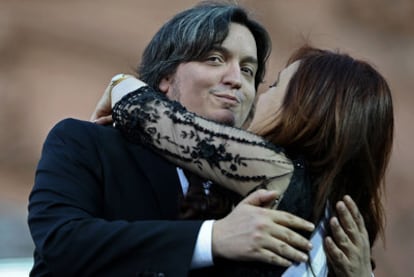Argentina's shadowy first son
Máximo Kirchner's powerbase group begins to irk many traditional Peronists
It includes two deputy ministers, dozens of public servants, eight national deputies, 15 provincial lawmakers and dozens of local council members. The majority of them are less than 40 years old, and there are some even younger than 30. They form the Peronist youth group, La Cámpora, and are led by Argentina's first son, Máximo Kirchner.
They are far from dominating national politics, but La Cámpora's power has been growing fast since the death of former President Néstor Kirchner in late 2010, and the group has won the support of his successor and widow, President Cristina Fernández de Kirchner.
Re-elected last October with 54 percent of the vote, Fernández de Kirchner wants people in her second-term government, which took office in December, who answer directly to her, says Nicolás Tereschuk, professor at the School of Latin American Social Sciences (Flacso). And one of the best sources for such support is La Cámpora, organized in 2003 by her son with the help of his father. The group is named after former President Héctor Cámpora, a leftist Peronist, who stepped aside after 49 days in office in 1973 to allow Juan Domingo Perón to resume power following his long exile in Madrid.
His youth movement called street protests to back the president against the farmers
According to its website, the group defends human rights, the "Latin American motherland," "industrial sovereignty," organized labor, and social justice causes.
Máximo Kirchner, 34, keeps a low profile and lives in his father's native Santa Cruz province in southern Argentina, where the late president served as governor. After abandoning his law and journalism studies, Máximo Kirchner began to devote his time to running his family's fortune and leading La Cámpora from the shadows. He never makes speeches but has always acted as a political consultant to his parents.
La Cámpora began gaining national attention during the standoff in 2008 between President Fernández de Kirchner and farmers over hikes in export tariffs. La Cámpora began organizing a series of street protests to defend the government's position.
The president hasn't appointed anyone from La Cámpora to her Cabinet, but there are two deputy ministers of economy and justice who are members of the organization. Máximo Kirchner's troops also include deputy secretaries of state, high-level public officials, and scores of government office workers. The president of state-owned Aerolíneas Argentinas is also a member.
"This new generation is causing a lot of tension," says Tereschuk. So much so that the president's former Cabinet chief, Alberto Fernández, had some harsh words for La Cámpora. "This is a strange thing - these youths who act like some kind of law officers upholding a certain ideology."
Soon after winning her re-election, a labor conflict broke out between the government and the pilots and technicians at Aerolíneas Argentina when the president of the national airline announced cutbacks to reduce a whopping deficit. Hugo Moyano, the powerful leader of the Peronist CGT union, backed labor and quickly broke off his alliance with Fernández de Kirchner. On the same day Moyano announced his break, he sarcastically called members of La Cámpora "those upright kids."
In another incident reflecting the tensions between those who are faithful to Fernández de Kirchner and the traditional Peronists, La Cámpora ordered all its members to resign en masse from their posts in the Santa Cruz provincial government after a violent labor dispute broke out when the governor came up with a bill freezing public wages and pushing back the retirement age.
Máximo Kirchner has never run for office but some media outlets predict that he may run for president in 2015, when his mother will have to step down because the Constitution prohibits her from seeking a third term. There had been conjecture some years back that Máximo would run for mayor of Río Gallegos, the capital of Santa Cruz, but for the moment he remains in the shadows.

Tu suscripción se está usando en otro dispositivo
¿Quieres añadir otro usuario a tu suscripción?
Si continúas leyendo en este dispositivo, no se podrá leer en el otro.
FlechaTu suscripción se está usando en otro dispositivo y solo puedes acceder a EL PAÍS desde un dispositivo a la vez.
Si quieres compartir tu cuenta, cambia tu suscripción a la modalidad Premium, así podrás añadir otro usuario. Cada uno accederá con su propia cuenta de email, lo que os permitirá personalizar vuestra experiencia en EL PAÍS.
¿Tienes una suscripción de empresa? Accede aquí para contratar más cuentas.
En el caso de no saber quién está usando tu cuenta, te recomendamos cambiar tu contraseña aquí.
Si decides continuar compartiendo tu cuenta, este mensaje se mostrará en tu dispositivo y en el de la otra persona que está usando tu cuenta de forma indefinida, afectando a tu experiencia de lectura. Puedes consultar aquí los términos y condiciones de la suscripción digital.
Últimas noticias
Most viewed
- Why we lost the habit of sleeping in two segments and how that changed our sense of time
- Trump’s obsession with putting his name on everything is unprecedented in the United States
- Pablo Escobar’s hippos: A serious environmental problem, 40 years on
- The Florida Keys tourist paradise is besieged by immigration agents: ‘We’ve never seen anything like this’
- Charles Dubouloz, mountaineering star, retires at 36 with a farewell tour inspired by Walter Bonatti








































